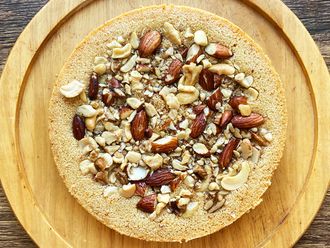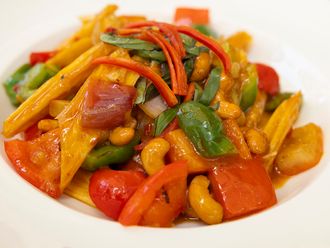
I opened my refrigerator the other night to complete disappointment. It wasn’t that I hadn’t made it to the market; in fact the refrigerator was full of food. Just a few days before, I had placed mountains of fresh vegetables and fruits in the fridge, only to return to wilted leafy greens, moldy berries, limp carrots and squishy eggplant. I felt as rotten as those vegetables when I stuffed so many untouched foods into the compost pile.
I do not have the time to make multiple trips to the market each week to restock the summer produce. So I did a little digging, with the help of the Berkeley, California-based Ecology Centre and other sources, to find out how I could keep my produce fresh, crisp and ready to feed my crew for a week after purchasing. What did I find? I found that storage is everything.
Starter tips
Buy fresh and local. It’s likely that a freshly picked fruit or vegetable will last longer than an item that has been riding on a truck or camped out in a warehouse for weeks.
Give your produce space to breathe and you will give it a longer shelf life. In other words, try not to overcrowd your crisper drawers or your fruit bowl. One layer deep is a good rule of thumb.
Do not store fruits and vegetables together; fruits emit a ripening agent that can ripen and spoil neighboring vegetables. (Placing a ripe banana next to almost anything is a surefire way to ripen the item in the adjacent seat. It’s the same story with any fruit that has started to brown, mold or sour; keep them away from the fresher pieces.)
Never seal fruits or vegetables in an airtight bag or you will hasten the decay.
Eat your most perishable items first, so perhaps plan for artichokes and asparagus to be eaten before cucumbers or cauliflower.
Produce storage guide
Vegetables
Asparagus: Store upright in a glass with water covering the bottom inch of the stems at room temperature for a week.
Beets: Cut off the tops and leaves to retain firmness, and store for one to two weeks in an open container in the refrigerator topped with a wet towel.
Brussels sprouts: Store in an open bowl or container in the refrigerator for one to two weeks.
Cabbage: Store uncut in the refrigerator for up to two weeks.
Carrots: Cut off the tops and leaves to retain firmness, and store for one to two weeks in an open container in the refrigerator topped with a wet towel.
Cauliflower: Store uncut in the refrigerator for a week.
Celery: Store uncut in the refrigerator for two weeks.
Corn: Truly best eaten the day it is picked. Otherwise, store in the refrigerator in its husk for a few days.
Cucumbers: Store at room temperature, not near bananas, melons or tomatoes.
Eggplant: Find a cool, dry, dark place other than the refrigerator.
Garlic: Find a cool, dry, dark place other than the refrigerator.
Green beans: Store in a produce bag or wrapped in a paper towel in the crisper drawer of the refrigerator.
Herbs: Pretend they are a bouquet of flowers and stick the stems in a glass of water and store in the fridge. Wash and use stems and leaves as needed.
Leafy greens: De-stem, then place leaves in a bowl with water and rinse until clean. Dry leaves and wrap in a dish towel, then store in the crisper for a week or more.
Mushrooms: Store in a paper bag in the crisper drawer of the refrigerator for a week. Wash just before using.
Onions: Find a cool, dry, dark place other than the refrigerator.
Potatoes: Find a cool, dry, dark place other than the refrigerator.
Radishes, turnips and parsnips: Cut off the tops and leaves to retain firmness, and store for a few weeks in an open container in the refrigerator with a wet towel on top.
Sprouts: Wrap in a paper towel or produce bag and store in refrigerator for three days.
Summer squash: Store in the refrigerator for five days.
Winter squash: Choose a cool, dry, dark place other than the refrigerator.
Tomatoes: Do not refrigerate, as they are cold-sensitive. Store them on the counter away from other fruits.
Fruits
Apples: Store in crisper drawer of refrigerator, or a cool, dark place outside of the refrigerator.
Avocados: Ripen in a brown paper bag at room temperature, move to the refrigerator when ripe.
Bananas: Do not refrigerate; keep separate from other fruits and vegetables.
Berries: Store unwashed in the refrigerator for one to two weeks, ideally in one layer in a paper bag.
Cherries: Store in the refrigerator unwashed for three to five days. Wash before serving.
Citrus: Store at room temperature because citrus fruits can absorb flavors from other foods in the refrigerator.
Grapes: Store in a paper bag in the fridge.
Kiwi: Keep at room temperature for a few days or in the refrigerator for a week.
Melon: Leave uncut at room temperature, out of the sun.
Mango: Store at room temperature until ripe, then move to the refrigerator.
Papaya: Store at room temperature until ripe ,then move to the refrigerator.
Pears: Keep at room temperature. Neighboring apples will hasten a pear’s ripening.
Stone fruit (apricots, nectarines): Store at room temperature stem-end down to ripen, or in the refrigerator when already ripe.
If you find yourself with a handful of wilted vegetables despite your best efforts to wrap and store them appropriately, make a soup. Saute wilted onion, carrots and celery, then add stock, beans, wilted dark leafy greens and a whole grain such as rice or barley. You’ll save the vegetables from the garbage and feed your family all at once.
Try composting any remaining vegetable scraps and inedible stems and leaves. If you do not have a the space at home for a compost pile or bin, try Compost Cab (www.compostcab.com) or the Compost Crew, (www.compostcrew.com), companies that will haul away your food waste, keep it out of landfills, and turn it into rich soil that nurtures the planet.
In my research, I found a National Resources Defense Council statistic stating that “if we wasted just 15 per cent less food, it would be enough to feed 25 million Americans.” If my own overflowing trash bin wasn’t enough reason for me to pay more attention when I unloaded the groceries, this certainly is.
Seidenberg is co-founder of Nourish Schools, a Washington, D.C.-based nutrition education company. Washington Post
















